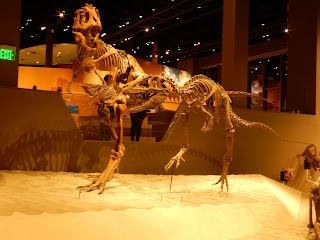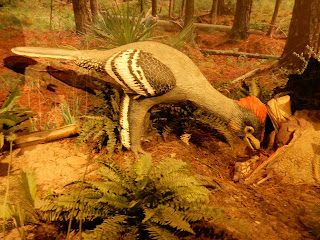The welcome reception at this year's SVP took attendees to the Natural History Museum of Utah. The main fossil exhibits are arranged roughly in chronological order, with younger fossils exhibited higher up in the building and older ones closer to the ground floor, threaded throughout by a sloping boardwalk. I consider it to be among the most impressive fossil displays I've visited, in terms of both content and setup.
A juvenile Columbian mammoth.
Megalonyx says, "Hi."
Uintatherium, one of the bizarre mammals of the early Paleogene.
An apparently unnamed dromaeosaurid.
A couple of juvenile Teratophoneus.
The giant alligatoroid Deinosuchus.
A smaller alligatoroid, Brachychampsa.
The large oviraptorosaur Hagryphus, mainly based on Anzu.
The skull of the saurolophine hadrosaur Gryposaurus.
The skull of the lambeosaurine hadrosaur Parasaurolophus.
An ornithomimid referred to Ornithomimus. A sizeable animal considering that we're viewing it from an elevated walkway.
The famous wall of ceratopsians, arranged phylogenetically. From left to right: Styracosaurus, Centrosaurus, Einiosaurus, Pachyrhinosaurus, Achelousaurus, Nasutoceratops, Diabloceratops, Chasmosaurus, Kosmoceratops, Anchiceratops, Triceratops, and Coahuilaceratops.
Off to the side are Protoceratops and Zuniceratops.
Ceratosaurus and Marshosaurus have a disagreement over a Stegosaurus carcass.
The whiplash tail of a mired Barosaurus passes beneath the walkway and arcs high above the heads of visitors. The sauropod is beset by several daring Allosaurus, but somehow this was the only picture I took of the mount. Others have a more representative record.
Size variation in Allosaurus.
The skull of Tanycolagreus, one of the more obscure Morrison theropods.
It was nice to see mounts of Nothronychus and Falcarius, but for unknown reasons I didn't take many good pictures of their heads. Their skulls are largely unknown, in any case.
This model of a troodont with colors lifted directly from Anchiornis was somewhat eyebrow-raising.
A model and mount of Lythronax.
Various arthropods from the Green River Formation.
Crossopholis, a paddlefish from the Green River.
I'd only just gotten out of the fossil exhibit when I received a Facebook message from Meig Dickson telling me that she'd found something in the biology exhibit upstairs that I absolutely had to see. Upon reaching the exhibit, I encountered an interactive tree of life, incredible in its scope and presentation.
However, what Meig had wanted me to see was the image they were using to represent protorosaurs on the interactive phylogeny. Oh, no...
Playing around with the phylogeny some more, we uncovered a number of other oddities. Most unusual was its apparent contention that a genus of extant brown algae is an extinct group of synapsids. Oops.
Hiccups with the interactives aside, the museum was rather impressive in how up to date the displays were. The wall of hominid skulls even includes the recently described Homo naledi.
A phylogeny of corvids.
In the display area for the geologic history of Utah was some more paleo-goodness: Seitaad, a basal sauropodomorph.
I shall conclude this post with the humble Triops, used as an example of species specialized for life in ephemeral desert pools.
Tuesday, November 8, 2016
Natural History Museum of Utah
Subscribe to:
Post Comments (Atom)














































This comment has been removed by the author.
ReplyDeletehttp://gifrific.com/wp-content/uploads/2012/06/You-Didnt-See-Anything-Madagascar.gif
Delete